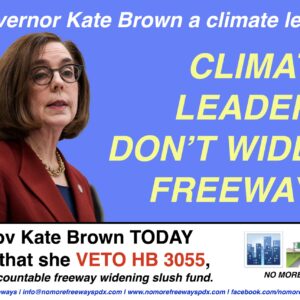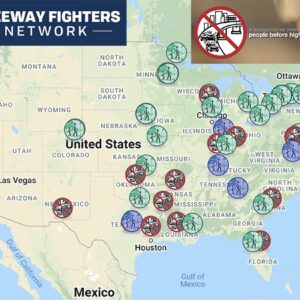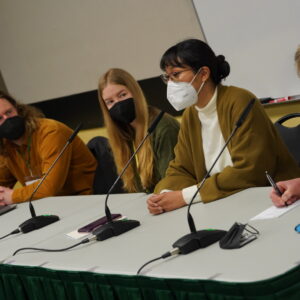
(Photo: Matt Giraud)
Written by Steph Routh, this is the first in our Women’s Bike Month interview series sponsored by the Community Cycling Center and Gladys Bikes.
Every day we travel past, on, or under structures and streets named for the people who had some relationship to its construction. Ladd’s Circle. Flanders Street. Naito Parkway. The Glenn Jackson Bridge.
Meeky Blizzard’s name is not attributed to a structure, because she made her mark on transportation and land use planning with the structure that was never constructed — the Western Bypass. Instead, the planned Western Bypass corridor from Tualatin to Hillsboro remains largely agricultural land, thanks to Meeky and other activists who started the group Sensible Transportation Options for People, also known by its apt acronym STOP. Meeky and other STOP members opposed the project and instead proposed alternate solutions that were eventually codified in the Land Use, Transportation, Air Quality (LUTRAQ) study.
After the demise of the Western Bypass in 1996 (which briefly re-emerged in the recent legislative session), Meeky went on to serve as Livable Communities Advisor to U.S. Congressman Earl Blumenauer until her retirement in 2012. Now living in rural Washington County, she still advocates for livable communities. Meeky testified against a freeway proposal in April, telling legislators that building freeways is “simply a waste of money.”
I recently sat down with Meeky in Portland City Hall to learn more about that fateful freeway fight and what lessons it might hold for today’s activists…
What got you started in transportation advocacy?
“The specter of a freeway in your community certainly gets your attention… The more I learned, the more I learned it was not only environmentally bad, but there had been no community participation, and it didn’t even make transportation sense.”
The specter of a freeway in your community certainly gets your attention. When I started opposing the Western Bypass, people said that was a noble concept, but it was already in the Regional Transportation Plan (RTP), and the funding was already lined up. People said, “What makes you think you can have any impact?” I wasn’t ready to have the idea of, “There is nothing I can do” seep into my life. That was how I got involved. The more I learned, the more I learned it was not only environmentally bad, but there had been no community participation, and it didn’t even make transportation sense.
Can you talk about why it didn’t make sense?
It would have taken less than 10% of the traffic of Highway 217 and would have saved four minutes of travel time. I learned that information from Washington County documents. I had majored in history, and it gave me a good background in tackling large amounts of information and coming up with ideas of my own. I spent a number of years doing technical writing on systems that I knew nothing about. I sold my services based on the idea that, if I can understand it, anyone can. And that turned out to be right. So volumes of transportation data did not turn out to be tough.
How did you get people to listen to you?
Some people were horrified because it would go through farmland. Some people thought it would be great because they’re tired of sitting in traffic. Those we were working with focused on the idea that, not only is this a bad idea, but we have better solutions, and here are what they are. So we focused on solutions.
Whom did you recruit?
Local residents certainly. And then we worked with different environmental groups and people who may not live in the area that thought the new freeway would be a bad idea for the region. We had gotten a lot of support from recent transplants from California and other places who said they had been told, “Just one more freeway,” and then saw their landscape disappear. We didn’t want to see that happen here.
Were there moments when you doubted the entire enterprise?
Of course.
What did you say to yourself?
There were so many other people who brought perspectives and broader support. I learned about the alternatives, particularly the land use alternatives. There were so many positive things to talk about that it was very motivating.
And the timing was right. There were staff members at various jurisdictions who came to us privately and said that they had misgivings, and then shared resources that we might find helpful. They offered some things we might want to highlight, some ways to frame the argument. Since this was the first freeway that was planned since the new land use laws, there were questions as to the best process regarding land use. We said that you need to think about the type of the community you want, and then look to transportation. So the whole discussion of the Western Bypass sparked an analysis at the state level of which land use goals took priority, and how ODOT and DLCD needed to work together to sort it out. The result of that discussion led to the creation of the Oregon Transportation Planning Rule, which adopted goals for reducing
How did you feel when it passed?
Amazed. It did great things for reducing parking spaces and a guarantee that land use would be considered before transportation. When we talked about land use, 1000 Friends of Oregon was eager to talk about how this could address suburban transportation. So we call it dumb luck.
If this had happened in the early 80s, there would have been so much need for jobs, it wouldn’t have had a chance of succeeding. The whole environment was ripe.

Meeky riding on the Hawthorne Bridge with People for Bikes President Tim Blumenthal in 2009.
Advertisement

With Washington County Commissioner Dick Schouten (left) and bicycle industry advocate Chris DiStefano at the 2009 National Bike Summit in Washington D.C.
How about now?
The good news is that, 25 years later, there are more examples of better planning and more studies about travel from freeways. When you put in a lane of travel, it creates induced demand. Cost is a big factor, that now it is not just about building the project but that maintenance is an issue. Our infrastructure is falling apart. There is a greater environmental sensitivity around environmental impacts. We are at the next level, but it is not a straight line.
“You don’t have to participate [in traffic] if you have good alternatives. There is no one mode that fits everyone. But it’s hard to tell people to take the bus if there is no bus service.”
In Washington County, the Urban Growth Boundary (UGB) has expanded, and there are a gazillion new houses. Roads are highly congested and it’s only going to get worse with more housing. There is a lot of pressure about widening the roads, especially if you look at NextDoor. Everyone wants things to be the way they were before. There continues to be a need to educate people on the broader things and the need for alternatives.
I remember Keith Bartholomew, the project manager for LUTRAQ, was talking once to Portland City Council. He said if you don’t like traffic, stay away from it. Do something else—walk, bike, take transit. You don’t have to participate if you have good alternatives. There is no one mode that fits everyone. But it’s hard to tell people to take the bus if there is no bus service.
The difference between stand-still traffic and flowing traffic is actually a very small percentage. It doesn’t take much to change traffic patterns.
What do you say to the person who responds to that argument, well that is why we need the Bypass?
I’d say sure, but at what cost? There’s the construction, loss of farmland, air quality, commuting costs, and the lifecycle of the freeway. And how much are you inducing? It will work short-term, but do we have the money?
During the recent Washington County Transportation Futures study, the City of Hillsboro paid for a flier to go to everyone in the City, inviting them to go to the website and get a huge response. They raffled off a year of gas, a transit pass, or a bike. They had a great number of people participate. The demographics exactly matched that for the County. It was a statistically relevant sample. Responses were all over the map, but people understood that you did need alternatives. One of the main reasons is that it’s more cost-effective.
What worked for you that you would advise of other activists?
“Focus on the local… Help local decision makers make sound decisions… And support local organizations who are pushing local leaders.”
Focus on the local, because that’s where good ideas come from. The whole issue of the Bypass study and LUTRAQ really influenced federal legislation. They usually have the most money, but priorities are at the local level. There is less and less money federally, so local communities have to come up with creative solutions to fund projects locally. This comes down to cost-effectiveness.
Certainly support people at the federal level who are doing the good work. Earl (Blumenauer) has definitely been doing that. Help local decision makers make sound decisions. And it can be as simple as holding a house party. But when you recognize people are doing good stuff, be sure you are there to help them. And support local organizations who are pushing local leaders.
Why did you never run for office?
I considered it at one point, but the timing didn’t seem right for my family. The only office I could run for was Washington County Commissioner or state legislator. I felt I was effective doing what I was doing.
Are there any other less visible things that you’re proud of?
I’m very pleased that my family recognizes my contributions. I think it set a good example for them. I’m pleased about that. I feel very fortunate that I’ve been able to do the work that I’ve done. I’m certainly not the only woman Earl has supported; there are numerous examples. And I’m proud of cycling across the US self-supported in our 50s! No one was more impressed than we were when we made it.
Who is your shero?
My Mom, for one thing. She was a quiet, persistent, loving person with a deep sense of place. I also think of Lynn Peterson (who’s currently running for Metro Council president). And Julia Pomeroy in Earl’s office.
What is one dream you have for the future?
That our communities become more accessible by the primary modes of transportation — walking and biking. Changing the language and changing the perception.
— Steph Routh is the communications director for the Community Cycling Center.
Never miss a story. Sign-up for the daily BP Headlines email.
BikePortland needs your support.





All Hail Meeky and STOP. The western bypass would have plowed right through the farm I grew up on along the banks of the Tualatin river. We lived under the cloud of this monster for many years. The amount of prime farm land and wildlife habitat that it would have destroyed for the sake of easy motoring are immense. Once the bypass was stopped for good, the U.S. fish and wildlife service was able to buy the property from my father and turn in in to part of the now significant bird refuge in the area. If not for Meeky and the freeway fighters this dynamic ecosystem and migratory bird stopover would have been turned in to a swirl of auto exhaust, asphalt and fast food fry huts.
A great thing that the Western Bypass was not built ! If it had been built, would the MAX Blue and Red line light rail lines have been built? I wonder if NW Skyline Blvd would have become a relief valve for that freeway.
It is dumb-founding that the new, zillion dollar 124th Ave project west of Tualatin from Washington County lacks any protected bike lanes. Awful planning.
“If I have seen further, it is by standing on the shoulders of giants.” – Isaac Newton
It’s always valuable to reflect on the unpayable debt that today’s activists owe to people like Meeky. Thanks for this post, Steph.
Wow I did not remember her connection to S-T-O-P…at our Honolulu pedestrian advocacy group in the late 90s we used a lot of their materials to educate ourselves as to what was possible for our community back then. Mahalo Meeky!
Thank you, Steph, for a super article. Living out in NW Multnomah County, I can’t imagine how this rural landscape would’ve changed with a freeway running through the hills and over Sauvie Island. I didn’t know about Meeky and was glad to learn this.
Meeky was and remains an inspiration to all of us who work to reduce our dependence on the automobile and expand transportation options and maybe save the planet! Thanks Meeky!
I moved to Portland in time to get to the LUTRAQ conference, and have admired Meeky’s work and tenacity ever since!
Wonderful interview and outstanding human being. Thank you for the article, and thank you, Meeky Blizzard! p.s…now that is a NAME. 🙂
Great article! Being a burb-dweller in NW Washington County, what kind of heaven-and-earth-moving kind of work would it take to get more frequent bus service? I started riding transit, and turned my 30-minute commute into 75 minutes each way. I’m doing it because… well… audiobooks and it’s the right thing to do. And my kids are older now. But it’s a damn hard sell for most car-driving burb-dwellers to turn an hour of commuting into 2 1/2 per day. I don’t think abandoning all the suburban infrastructure en masse is going to happen any time soon. A western freeway sounds good in a knee-jerk kind of way.
Thank you Meeky Blizzard for all your work.
–Tina, the Tri-Met-riding burb dweller.
I worked with Meeky at Earl’s office for a couple years. She is a very warm, frank person, a great communicator, and a wealth of knowledge. Thanks for the profile!